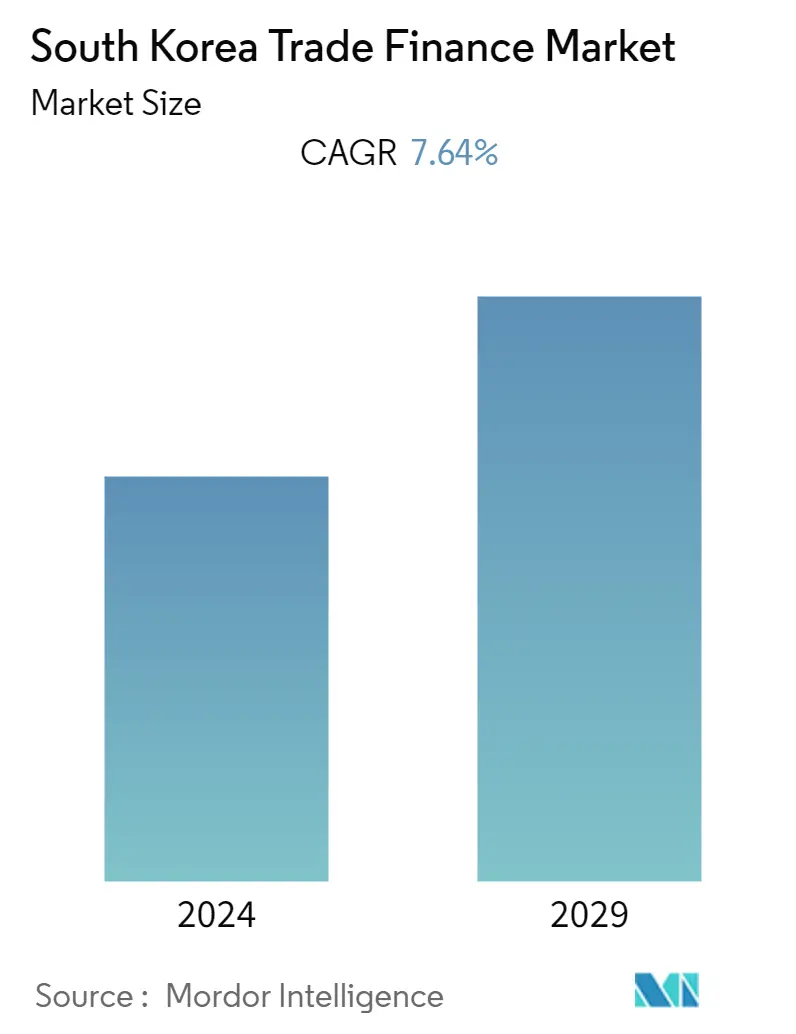Market Size of South Korea Trade Finance Industry

| Study Period | 2020 - 2029 |
| Base Year For Estimation | 2023 |
| Forecast Data Period | 2024 - 2029 |
| Historical Data Period | 2020 - 2022 |
| CAGR | 7.64 % |
| Market Concentration | Medium |
Major Players_-_Copy.webp)
*Disclaimer: Major Players sorted in no particular order |
South Korea Trade Finance Market Analysis
South Korea Trade Finance Market is estimated to be at USD 1.8 billion in the current year and witnessing a growth rate of 7.64% during the forecast period.
Depending on the degree of confidence between counterparties and the amount of funding required from banks, trade finance can take many different forms. If the transaction only involves the importer and exporter, it can be completed on an open account basis or a cash-in-advance basis (money is received before items are dispatched). Banks nevertheless play a part. To reduce the risk of non-payment, banks provide products. The exporter asks the exporter's bank to produce documents and obtain money from the importer as part of the documented collection.
Early in 2022, the Omicron variant's popularity caused South Korea's COVID-19 numbers to skyrocket. Even with the COVID pandemic, Korean growth has been consistent. However, inflation has risen, primarily due to increasing prices for imported petroleum and industrial inputs.
Additionally, American businesses have been collaborating with Korean local businesses to increase market prospects in third-country markets including ASEAN, the Middle East, and other markets in the Indo-Pacific. With exports of goods and services accounting for 36% of GDP in 2020, Korea will continue to be one of the industrialised countries most dependent on exports. Korea serves as both a market destination for American goods and services and a hub for market development into other countries because to its strong maritime and air freight infrastructure.
South Korea Trade Finance Industry Segmentation
Trade finance refers to the financial products and services used by businesses to facilitate cross-border trade and commerce. Commerce financing makes it easier for importers and exporters to conduct business through trade. Trade finance is a general term that includes a wide range of financial tools used by companies and banks to streamline trade operations. A complete analysis of the South Korea Trade Finance Market, which includes an assessment of the emerging trends by segments, significant changes in market dynamics, and a market overview, is covered in the report. The South Korea Trade Finance Market is segmented by Service Provider (Banks, Trade Finance Companies, Insurance Companies, and Others) and By Application (Domestic and International). The report offers market size and forecasts for the South Korea Trade Finance Market in value (USD Million) for all the above segments.
| Service Provider | |
| Banks | |
| Trade Finance Companies | |
| Insurance Companies | |
| Others |
| Application | |
| Domestic | |
| International |
South Korea Trade Finance Market Size Summary
The South Korean trade finance market is experiencing a robust growth trajectory, driven by its significant reliance on exports and the strategic role of banks in facilitating international trade transactions. The market is characterized by various forms of trade finance, including open account and cash-in-advance transactions, with banks providing essential products to mitigate payment risks. Despite challenges posed by the COVID-19 pandemic and inflationary pressures from rising import costs, South Korea's economy remains heavily dependent on exports, which constitute a substantial portion of its GDP. The country's strong maritime and air freight infrastructure positions it as a key player in global trade, serving both as a destination for American goods and a hub for expanding market reach into regions like ASEAN and the Middle East. However, fluctuations in currency values, particularly the devaluation of the Chinese yuan, have impacted South Korean exports, with the automotive sector facing significant declines, while smartphone exports contend with fierce competition from Chinese manufacturers.
Small and Medium-Sized Enterprises (SMEs) are pivotal to South Korea's economic landscape, accounting for a majority of businesses, employment, and exports. The government has been proactive in supporting SMEs, particularly through the Ministry of SMEs and Startups, which aims to bolster job creation and address youth unemployment. In response to the pandemic, the government expanded initiatives to encourage digital technology adoption among SMEs, facilitating automation, remote work, and digital cross-border sales. The trade finance market in South Korea is competitive, with both domestic and international players like Bank of America, Citibank, and Woori Bank actively participating. Innovations such as Shinhan Bank's big data-driven anti-money laundering system highlight efforts to enhance market competitiveness. Additionally, international trade fairs have facilitated significant sales, underscoring the market's potential for further expansion and increased competitiveness in the global trade finance arena.
South Korea Trade Finance Market Size - Table of Contents
-
1. MARKET DYNAMICS AND INSIGHTS
-
1.1 Market Overview
-
1.2 Market Drivers
-
1.3 Market Restraints
-
1.4 Industry Attractiveness - Porters' Five Forces Analysis
-
1.4.1 Threat of New Entrants
-
1.4.2 Bargaining Power of Buyers
-
1.4.3 Bargaining Power of Suppliers
-
1.4.4 Threat of Substitutes
-
1.4.5 Intensity of Competitive Rivalry
-
-
1.5 Insights on Various Regulatory Trends Shaping Trade Finance Market
-
1.6 Insights on Impact of Technology and Innovation in Trade Finance Market
-
1.7 Impact of COVID-19 on the Market
-
-
2. MARKET SEGMENTATION
-
2.1 Service Provider
-
2.1.1 Banks
-
2.1.2 Trade Finance Companies
-
2.1.3 Insurance Companies
-
2.1.4 Others
-
-
2.2 Application
-
2.2.1 Domestic
-
2.2.2 International
-
-
South Korea Trade Finance Market Size FAQs
What is the current South Korea Trade Finance Market size?
The South Korea Trade Finance Market is projected to register a CAGR of 7.64% during the forecast period (2024-2029)
Who are the key players in South Korea Trade Finance Market?
Bank of America, Bank of New York, Citibank, Woori Bank and Nonghyup Bank are the major companies operating in the South Korea Trade Finance Market.

